一、整合原理
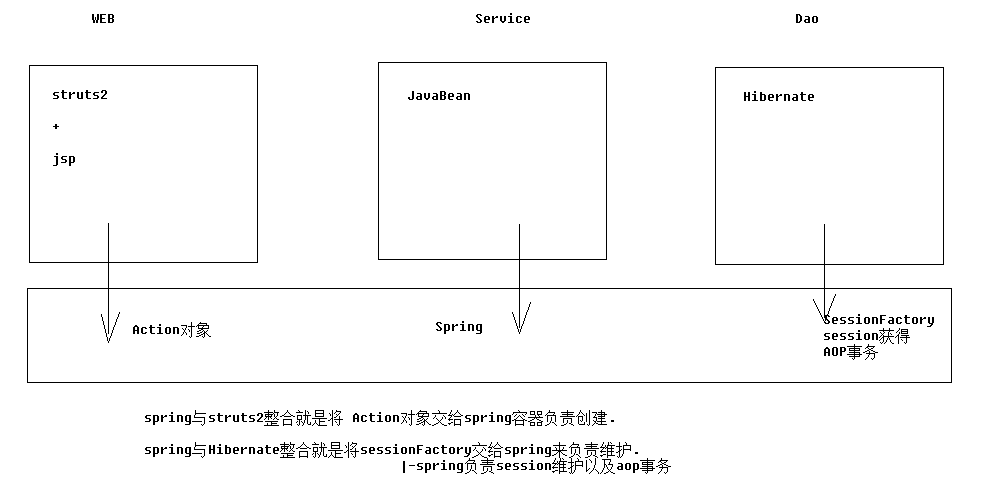
二、导包(41个)
1.hibernate
(1)hibernate/lib/required
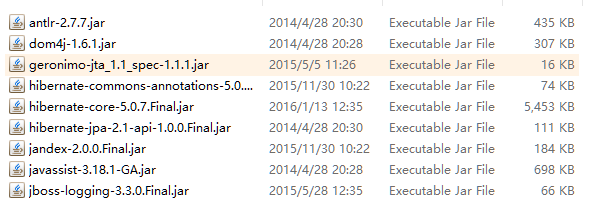
(2)hibernate/lib/jpa | java persist api java的持久化规范(接口)

(3)数据库驱动

2.struts2
(1)struts-blank.war/web-inf/lib/*
注意:javassist-3.18.1-ga.jar包与hibernate中的重复(只保留高版本即可)
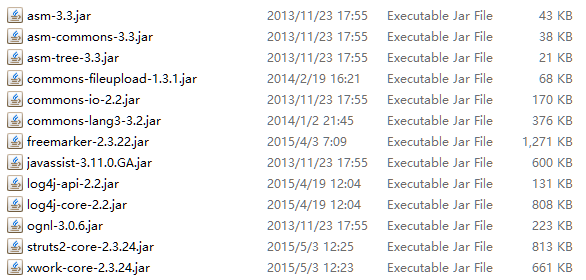
(2)struts整合spring插件包
注意:这个包一旦导入,那么struts2在启动时就会寻找spring容器.找不到将会抛出异常

3.spring
(1)基本:4+2
core | beans | context | expression | logging | log4j
(2)整合web:web包
spring-web
(3)整合aop:4个
spring-aop | spring-aspect | aop联盟 | aopweaving
(4)整合hibernate和事务:4个
spring-jdbc | spring-tx | c3p0 | spring-orm
(5)整合junit4测试:test包
spring-test
4.标签库
standard.jar | jstl-1.2.jar
三、单独配置spring容器
1.创建applicationcontext.xml,并导入约束(4个) beans | context | aop | tx

|
1
2
3
4
5
6
7
8
9
10
11
12
13
14
|
<?xml version="1.0" encoding="utf-8"?><beans xmlns:xsi="http://www.w3.org/2001/xmlschema-instance" xmlns="http://www.springframework.org/schema/beans" xmlns:context="http://www.springframework.org/schema/context" xmlns:aop="http://www.springframework.org/schema/aop" xmlns:tx="http://www.springframework.org/schema/tx" xsi:schemalocation="http://www.springframework.org/schema/beans http://www.springframework.org/schema/beans/spring-beans-4.2.xsd http://www.springframework.org/schema/context http://www.springframework.org/schema/context/spring-context-4.2.xsd http://www.springframework.org/schema/aop http://www.springframework.org/schema/aop/spring-aop-4.2.xsd http://www.springframework.org/schema/tx http://www.springframework.org/schema/tx/spring-tx-4.2.xsd "> <bean name="useraction" class="cn.xyp.web.action.useraction"></bean></beans> |
2.配置spring随项目启动(web.xml)
|
1
2
3
4
5
6
7
8
9
|
<!-- 让spring随web启动而创建的监听器 --><listener> <listener-class>org.springframework.web.context.contextloaderlistener</listener-class></listener><!-- 配置spring配置文件位置参数 --><context-param> <param-name>contextconfiglocation</param-name> <param-value>classpath:applicationcontext.xml</param-value></context-param> |
四、单独配置struts2
1.配置struts2主配置文件(struts.xml)
|
1
2
3
4
5
6
7
8
9
10
11
12
|
<?xml version="1.0" encoding="utf-8"?> <!doctype struts public "-//apache software foundation//dtd struts configuration 2.3//en" "http://struts.apache.org/dtds/struts-2.3.dtd"> <struts> <package name="crm" namespace="/" extends="struts-default"> <action name="useraction_*" class="cn.xyp.web.action.useraction" method="{1}"> <result name="success">/success.jsp</result> </action> </package></struts> |
2.配置struts2核心过滤器到web.xml
|
1
2
3
4
5
6
7
8
9
10
|
<!-- struts2核心过滤器 --><filter> <filter-name>struts2</filter-name> <filter-class>org.apache.struts2.dispatcher.ng.filter.strutsprepareandexecutefilter</filter-class></filter><filter-mapping> <filter-name>struts2</filter-name> <url-pattern>/*</url-pattern></filter-mapping> |
五、struts2与spring整合
1.导包(已经导入)
struts2-spring-plugin-2.3.24.jar
2.配置常量
查看默认配置文件从31行开始找到要配置的变量。
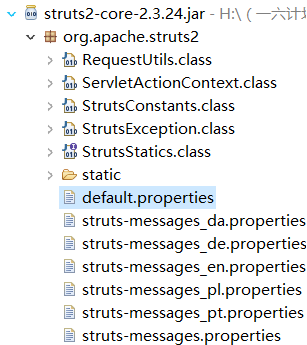
|
1
2
3
4
5
6
7
8
|
### if specified, the default object factory can be overridden here### note: short-hand notation is supported in some cases, such as "spring"### alternatively, you can provide a com.opensymphony.xwork2.objectfactory subclass name here# struts.objectfactory = spring### specifies the autowiring logic when using the springobjectfactory.### valid values are: name, type, auto, and constructor (name is the default)struts.objectfactory.spring.autowire = name |
添加常量到struts.xml
|
1
2
3
4
|
<!-- # struts.objectfactory = spring 将action的创建交给spring容器 struts.objectfactory.spring.autowire = name spring负责装配action依赖属性 --><constant name="struts.objectfactory" value="spring"></constant> |
3.整合方案1:struts2自己创建action,spring负责组装依赖属性(了解)
|
1
2
3
4
5
6
7
|
<!-- 整合方案1:class属性上仍然配置action的完整类名 struts2仍然创建action,由spring负责组装action中的依赖属性 --> <action name="useraction_*" class="cn.xyp.web.action.useraction" method="{1}" > <result name="tohome" type="redirect" >/index.htm</result> <result name="error" >/login.jsp</result> </action> |
不推荐理由:最好由spring完整管理action的生命周期.spring中功能才应用到action上.
4.整合方案2:spring负责创建action以及组装.(推荐)
applicationcontext.xml:
|
1
2
3
4
5
|
<!-- action --><!-- 注意:action对象作用范围一定是多例的.这样才符合struts2架构 --><bean name="useraction" class="cn.itcast.web.action.useraction" scope="prototype" > <property name="userservice" ref="userservice" ></property></bean> |
struts.xml:
|
1
2
3
4
5
6
7
8
9
|
<!-- 整合方案2:class属性上填写spring中action对象的beanname 完全由spring管理action生命周期,包括action的创建 注意:需要手动组装依赖属性 --><action name="useraction_*" class="useraction" method="{1}" > <result name="tohome" type="redirect" >/index.htm</result> <result name="error" >/login.jsp</result></action> |
六、单独配置hibernate
1.导入实体类&orm元数据
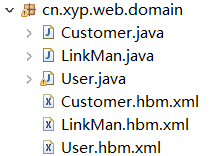
举例:user.java
|
1
2
3
4
5
6
7
8
9
10
11
12
13
14
15
16
17
18
19
20
21
22
23
24
25
26
27
28
29
30
31
32
33
34
35
36
37
38
39
40
41
42
43
44
45
46
47
|
package cn.xyp.web.domain;import java.util.hashset;import java.util.set;public class user { private long user_id; private string user_code; private string user_name; private string user_password; private character user_state; public long getuser_id() { return user_id; } public void setuser_id(long user_id) { this.user_id = user_id; } public string getuser_code() { return user_code; } public void setuser_code(string user_code) { this.user_code = user_code; } public string getuser_name() { return user_name; } public void setuser_name(string user_name) { this.user_name = user_name; } public string getuser_password() { return user_password; } public void setuser_password(string user_password) { this.user_password = user_password; } public character getuser_state() { return user_state; } public void setuser_state(character user_state) { this.user_state = user_state; } @override public string tostring() { return "user [user_id=" + user_id + ", user_code=" + user_code + ", user_name=" + user_name + ", user_password=" + user_password + "]"; }} |
user.hbm.xml:
|
1
2
3
4
5
6
7
8
9
10
11
12
13
14
15
16
|
<?xml version="1.0" encoding="utf-8"?><!doctype hibernate-mapping public "-//hibernate/hibernate mapping dtd 3.0//en" "http://www.hibernate.org/dtd/hibernate-mapping-3.0.dtd"><hibernate-mapping package="cn.xyp.domain" > <class name="user" table="sys_user" > <id name="user_id" > <generator class="native"></generator> </id> <property name="user_code" ></property> <property name="user_name" ></property> <property name="user_password" ></property> <property name="user_state" ></property> </class></hibernate-mapping> |
2.配置主配置文件(hibernate.xml)
|
1
2
3
4
5
6
7
8
9
10
11
12
13
14
15
16
17
18
19
20
21
22
23
24
25
26
27
28
29
30
31
32
33
34
35
36
37
|
<?xml version="1.0" encoding="utf-8"?><!doctype hibernate-configuration public "-//hibernate/hibernate configuration dtd 3.0//en" "http://www.hibernate.org/dtd/hibernate-configuration-3.0.dtd"><hibernate-configuration> <session-factory> <!-- 数据库驱动 --> <property name="hibernate.connection.driver_class">com.mysql.jdbc.driver</property> <!-- 数据库url --> <property name="hibernate.connection.url">jdbc:mysql:///crm_32</property> <!-- 数据库连接用户名 --> <property name="hibernate.connection.username">root</property> <!-- 数据库连接密码 --> <property name="hibernate.connection.password">1234</property> <!-- 数据库方言 注意: mysql在选择方言时,请选择最短的方言. --> <property name="hibernate.dialect">org.hibernate.dialect.mysqldialect</property> <!-- 将hibernate生成的sql语句打印到控制台 --> <property name="hibernate.show_sql">true</property> <!-- 将hibernate生成的sql语句格式化(语法缩进) --> <property name="hibernate.format_sql">true</property> <!-- 自动导出表结构. 自动建表 --> <property name="hibernate.hbm2ddl.auto">update</property> <!-- 引入实体配置文件 --> <mapping resource="cn/xyp/domain/customer.hbm.xml" /> <mapping resource="cn/xypt/domain/linkman.hbm.xml" /> <mapping resource="cn/xyp/domain/user.hbm.xml" /> </session-factory></hibernate-configuration> |
七、spring整合hibernate
1.整合原理
将sessionfactory对象交给spring容器管理
2.在spring中配置sessionfactory
(1)配置方案一:(了解)
|
1
2
3
4
|
<!-- 加载配置方案1:仍然使用外部的hibernate.cfg.xml配置信息 --> <bean name="sessionfactory" class="org.springframework.orm.hibernate5.localsessionfactorybean" > <property name="configlocation" value="classpath:hibernate.cfg.xml" ></property> </bean> |
(2)配置方案二:(推荐)
|
1
2
3
4
5
6
7
8
9
10
11
12
13
14
15
16
17
18
19
20
21
22
23
|
<!-- 加载配置方案2:在spring配置中放置hibernate配置信息 --><bean name="sessionfactory" class="org.springframework.orm.hibernate5.localsessionfactorybean" > <!-- 将连接池注入到sessionfactory, hibernate会通过连接池获得连接 --> <property name="datasource" ref="datasource" ></property> <!-- 配置hibernate基本信息 --> <property name="hibernateproperties"> <props> <!-- 必选配置 --> <prop key="hibernate.connection.driver_class" >com.mysql.jdbc.driver</prop> <prop key="hibernate.connection.url" >jdbc:mysql:///crm_32</prop> <prop key="hibernate.connection.username" >root</prop> <prop key="hibernate.connection.password" >1234</prop> <prop key="hibernate.dialect" >org.hibernate.dialect.mysqldialect</prop> <!-- 可选配置 --> <prop key="hibernate.show_sql" >true</prop> <prop key="hibernate.format_sql" >true</prop> <prop key="hibernate.hbm2ddl.auto" >update</prop> </props> </property> <!-- 引入orm元数据,指定orm元数据所在的包路径,spring会自动读取包中的所有配置 --> <property name="mappingdirectorylocations" value="classpath:cn/itcast/domain" ></property></bean> |
八、spring整合c3p0连接池
1.配置db.properties
|
1
2
3
4
|
jdbc.jdbcurl=jdbc:mysql:///xyp_crmjdbc.driverclass=com.mysql.jdbc.driverjdbc.user=rootjdbc.password=123456 |
2.引入连接池到spring中
|
1
2
3
4
5
6
7
8
9
|
<!-- 读取db.properties文件 --><context:property-placeholder location="classpath:db.properties" /><!-- 配置c3p0连接池 --><bean name="datasource" class="com.mchange.v2.c3p0.combopooleddatasource" > <property name="jdbcurl" value="${jdbc.jdbcurl}" ></property> <property name="driverclass" value="${jdbc.driverclass}" ></property> <property name="user" value="${jdbc.user}" ></property> <property name="password" value="${jdbc.password}" ></property></bean> |
3.将连接池注入给sessionfactory
|
1
2
3
|
<bean name="sessionfactory" class="org.springframework.orm.hibernate5.localsessionfactorybean" > <!-- 将连接池注入到sessionfactory, hibernate会通过连接池获得连接 --> <property name="datasource" ref="datasource" ></property> |
九、spring整合hibernate环境操作数据库
1.dao类创建:继承hibernatedaosupport
注意:项目中要确保使用统一版本。

|
1
2
|
//hibernatedaosupport 为dao注入sessionfactorypublic class userdaoimpl extends hibernatedaosupport implements userdao { |
2.hibernate模板的操作
(1)execute
|
1
2
3
4
5
6
7
8
9
10
11
12
13
|
@overridepublic user getbyusercode(final string usercode) { //hql return gethibernatetemplate().execute(new hibernatecallback<user>() { @override public user doinhibernate(session session) throws hibernateexception { string hql = "from user where user_code = ? "; query query = session.createquery(hql); query.setparameter(0, usercode); user user = (user) query.uniqueresult(); return user; } }); |
(2)findbycriteria
|
1
2
3
4
5
6
7
8
9
10
11
12
|
//criteriadetachedcriteria dc = detachedcriteria.forclass(user.class);dc.add(restrictions.eq("user_code", usercode));list<user> list = (list<user>) gethibernatetemplate().findbycriteria(dc); if(list != null && list.size()>0){ return list.get(0);}else{ return null;} |
3.spring中配置dao
|
1
2
3
4
5
|
<!-- dao --><bean name="userdao" class="cn.xyp.dao.impl.userdaoimpl" > <!-- 注入sessionfactory --> <property name="sessionfactory" ref="sessionfactory"></property></bean> |
十、spring的aop事务
1.准备工作
|
1
2
3
4
|
<!-- 核心事务管理器 --><bean name="transactionmanager" class="org.springframework.orm.hibernate5.hibernatetransactionmanager" > <property name="sessionfactory" ref="sessionfactory" ></property></bean> |
2.xml配置aop事务
(1)配置通知
|
1
2
3
4
5
6
7
8
9
10
11
12
13
|
<!-- 配置通知 --><tx:advice id="txadvice" transaction-manager="transactionmanager" > <tx:attributes> <tx:method name="save*" isolation="repeatable_read" propagation="required" read-only="false" /> <tx:method name="persist*" isolation="repeatable_read" propagation="required" read-only="false" /> <tx:method name="update*" isolation="repeatable_read" propagation="required" read-only="false" /> <tx:method name="modify*" isolation="repeatable_read" propagation="required" read-only="false" /> <tx:method name="delete*" isolation="repeatable_read" propagation="required" read-only="false" /> <tx:method name="remove*" isolation="repeatable_read" propagation="required" read-only="false" /> <tx:method name="get*" isolation="repeatable_read" propagation="required" read-only="true" /> <tx:method name="find*" isolation="repeatable_read" propagation="required" read-only="true" /> </tx:attributes></tx:advice> |
(2)配置织入
|
1
2
3
4
5
6
7
|
<!-- 配置将通知织入目标对象配置切点配置切面 --><aop:config> <aop:pointcut expression="execution(* cn.itcast.service.impl.*serviceimpl.*(..))" id="txpc"/> <aop:advisor advice-ref="txadvice" pointcut-ref="txpc" /></aop:config> |
3.注解配置aop事务
(1)开启注解事务
|
1
2
|
<!-- 开启注解事务 --><tx:annotation-driven transaction-manager="transactionmanager" /> |
(2)service类中使用注解
|
1
2
|
@transactional(isolation=isolation.repeatable_read,propagation=propagation.required,readonly=true)public class userserviceimpl implements userservice{ |
|
1
2
3
4
5
|
@override@transactional(isolation=isolation.repeatable_read,propagation=propagation.required,readonly=false)public void saveuser(user u) { ud.save(u);} |
十一、扩大session作用范围
1.配置filter
为了避免使用懒加载时出现no-session问题.需要扩大session的作用范围。
|
1
2
3
4
5
6
7
8
9
10
11
12
13
|
<!-- 扩大session作用范围 注意: 任何filter一定要在struts的filter之前调用 因为struts是不会放行的 --> <filter> <filter-name>opensessioninview</filter-name> <filter-class>org.springframework.orm.hibernate5.support.opensessioninviewfilter</filter-class></filter><filter-mapping> <filter-name>opensessioninview</filter-name> <url-pattern>/*</url-pattern></filter-mapping> |
十二、练习:用户登录
1.struts.xml核心配置
|
1
2
3
4
5
6
7
8
9
10
11
12
13
14
15
16
17
18
19
20
21
22
|
<struts> <!-- # struts.objectfactory = spring 将action的创建交给spring容器 struts.objectfactory.spring.autowire = name spring负责装配action依赖属性 --> <constant name="struts.objectfactory" value="spring"></constant> <package name="crm" namespace="/" extends="struts-default" > <global-exception-mappings> <exception-mapping result="error" exception="java.lang.runtimeexception"></exception-mapping> </global-exception-mappings> <!-- 整合方案:class属性上填写spring中action对象的beanname 完全由spring管理action生命周期,包括action的创建 注意:需要手动组装依赖属性 --> <action name="useraction_*" class="useraction" method="{1}" > <result name="tohome" type="redirect" >/index.htm</result> <result name="error" >/login.jsp</result> </action> </package></struts> |
2.action代码
|
1
2
3
4
5
6
7
8
9
10
11
12
13
14
15
16
17
18
19
20
21
22
23
24
|
public class useraction extends actionsupport implements modeldriven<user> { private user user = new user(); private userservice userservice ; public void setuserservice(userservice userservice) { this.userservice = userservice; } public string login() throws exception { //1 调用service执行登陆逻辑 user u = userservice.getuserbycodepassword(user); //2 将返回的user对象放入session域 actioncontext.getcontext().getsession().put("user", u); //3 重定向到项目首页 return "tohome"; } @override public user getmodel() { return user; }} |
2.service核心代码
|
1
2
3
4
5
6
7
8
9
10
11
12
13
14
|
public user getuserbycodepassword(user u) { // 1 根据登陆名称查询登陆用户 user existu = ud.getbyusercode(u.getuser_code()); // 2 判断用户是否存在.不存在=>抛出异常,提示用户名不存在 if (existu == null) { throw new runtimeexception("用户名不存在!"); } // 3 判断用户密码是否正确=>不正确=>抛出异常,提示密码错误 if (!existu.getuser_password().equals(u.getuser_password())) { throw new runtimeexception("密码错误!"); } // 4 返回查询到的用户对象 return existu;} |
3.dao核心代码
|
1
2
3
4
5
6
7
8
9
10
11
12
13
14
15
|
public user getbyusercode(final string usercode) { //criteria detachedcriteria dc = detachedcriteria.forclass(user.class); dc.add(restrictions.eq("user_code", usercode)); list<user> list = (list<user>) gethibernatetemplate().findbycriteria(dc); if(list != null && list.size()>0){ return list.get(0); }else{ return null; } } |
以上就是本文的全部内容,希望对大家的学习有所帮助,也希望大家多多支持服务器之家。
原文链接:http://www.cnblogs.com/xieyupeng/p/7108141.html?utm_source=tuicool&utm_medium=referral

















